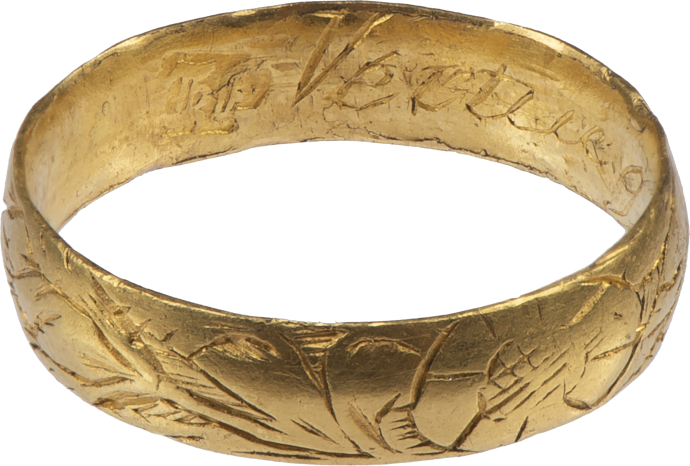Posy Ring inscription Vertue Gaineth Glory



Posy Ring ‘Vertue Gaineth Glory’
, England, c. 1700



Posy Ring ‘Vertue Gaineth Glory’
Description
Posy ring featuring floral decoration including daisies and tulips
Wide gold band, plain on the interior with engraved English inscription in italic script “Vertue Gaineth Glory.” The slightly convex exterior is richly engraved with frieze-like floral decoration including daisies and tulips. The ring shows traces of age and wear and is in good wearable condition.
The rectangular punch with maker’s mark inside the hoop is indistinct and shows Gothic letters, possibly the initials ‘GP’ or ‘TP’. However the name of the goldsmith cannot be identified from this.
Literature:
Messages of romantic love on jewelry and mottoes or inscriptions on plain gold bands go back to the Middle Ages. Beginning in the thirteenth century ring brooches and rings were given as love tokens. The language of love was expressed in words and amatory motifs, like here in the language of flowers: the daisy is associated with love, the tulip – originating from Persian – is symbolic of true love (see: Marina Heilmeyer, The Language of Flowers. Symbols and Myths, Prestel, Munich, London, New York 2001, pp. 56, 82, 94).
The name “posy” is derived from “poésie” meaning poetry. Inscriptions along the hoop are poetic expressions of love and affection, as on this ring “Vertue Gaineth Glory.” The tradition of giving posy rings was truly British and they were exchanged either between friends, relatives or lovers preceding matrimony or as a sign of betrothal. The message is discreetly concealed inside the hoop and its content known only to the wearer and giver. Posy rings even feature in the plays of William Shakespeare, such as in Hamlet (III, 2, 162) “Is this a prologue, or the posy of a ring.”
Joan Evans records two variations of this motto in differing spellings (Evans 1931, p. 105). One of the rings with this posy is in the British Museum, London (Dalton 1912, no. 1314).
For a history of posy rings with extensive examples ranging from the medieval period to eighteenth century, see: Scarisbrick 2021 and further information on posies: Evans, 1931; Anon., A Garland of Love: A Collection of Posy-Ring Mottoes, London 1907; Dalton 1912, pp. 174 ff.; Scarisbrick 2007, pp. 74 ff., Taylor and Scarisbrick 1978; Oman 1974, pp. 39 ff.